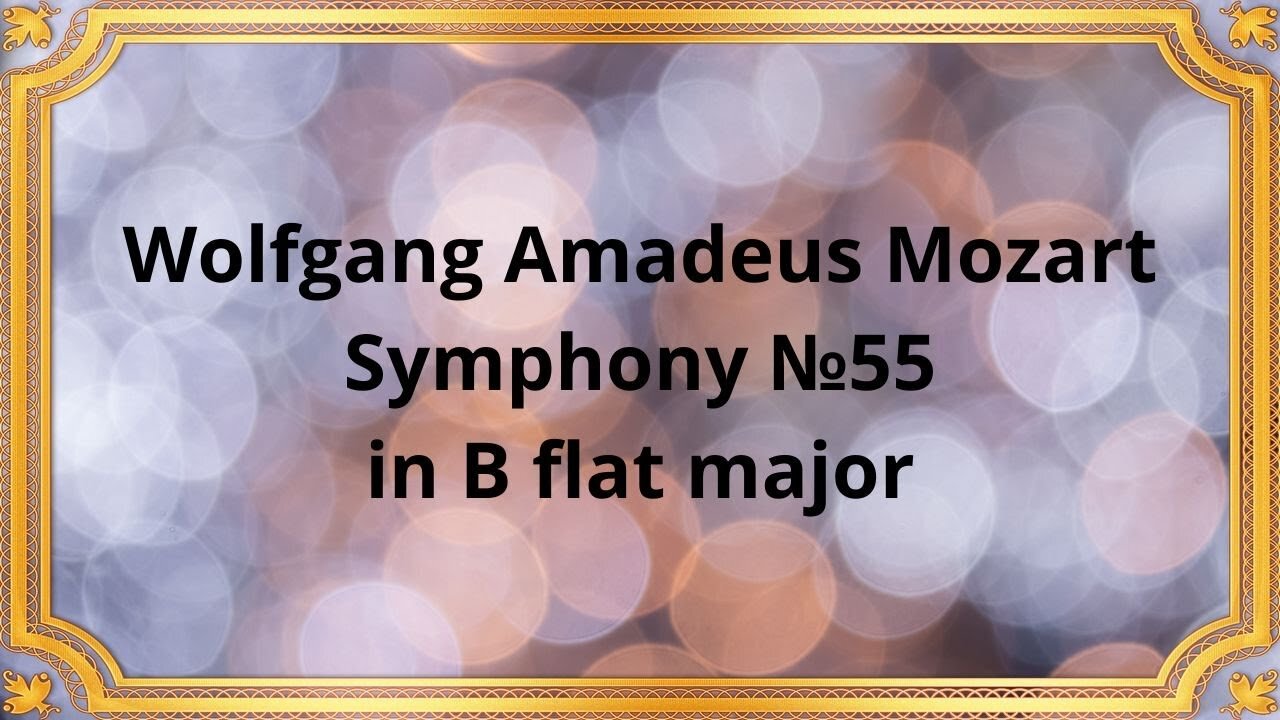Premium Only Content

Wolfgang Amadeus Mozart Symphony №55 in B flat major
#Mozart#Chamber_music#Classical_music#Symphony#Musical_composition
Wolfgang Amadeus Mozart is a celebrated composer who left a legacy of timeless music that continues to inspire audiences worldwide. One of his notable works is Symphony No. 55 in B flat major, a masterpiece that exemplifies his skillful use of orchestration and dynamic contrasts. In this article, we'll take a closer look at this remarkable symphony, exploring its key features and why it remains a standout piece in the classical music canon.
Mozart's Symphony No. 55 in B flat major: An Overview
Symphony No. 55 in B flat major is a three-movement work for a full orchestra. It was composed by Mozart in 1774 when he was just 18 years old. The symphony begins with a lively Allegro that features a series of catchy themes and virtuosic flourishes for the orchestra. The second movement is a serene Andante, with a delicate theme that is passed back and forth between the various sections of the orchestra. The final movement is a sprightly Allegro, with a jaunty melody and intricate counterpoint that showcases Mozart's mastery of orchestration.
Mozart's Symphony No. 55 in B flat major is a significant work in his oeuvre, as well as in the wider classical music tradition. It is known for its intricate harmonies, dynamic contrasts, and engaging melodies, which showcase Mozart's skillful use of orchestration and counterpoint.
The symphony's popularity is due in part to its accessibility and engaging melodies. The catchy themes in the first and third movements, in particular, have become beloved staples of the classical music canon. Additionally, it is a piece that is both challenging and approachable, making it a popular choice for both performers and audiences alike.
Whether you are a seasoned classical music fan or a newcomer to the genre, Symphony No. 55 in B flat major is a must-listen. Its engaging melodies, intricate harmonies, and dynamic contrasts make it a fascinating and enjoyable work to explore. Additionally, its historical significance and enduring popularity make it a valuable addition to any music collection.
Moreover, Symphony No. 55 in B flat major is an excellent example of Mozart's skill and creativity as a composer. It showcases his mastery of orchestration and dynamic contrast, as well as his ability to create engaging melodies and harmonies that have stood the test of time.
Conclusion
Mozart's Symphony No. 55 in B flat major is a masterpiece that exemplifies his skill as a composer. Its engaging melodies, intricate harmonies, and dynamic contrasts make it a significant work in the classical music tradition. Whether you are a longtime classical music fan or a newcomer to the genre, this symphony is a must-listen, and a valuable addition to any music collection.
-
 20:26
20:26
Classical music_Music Inspiration
19 days agoJohann Sebastian Bach Orchestral Suite No. 2 in B minor, BWV 1066
522 -
 46:55
46:55
The Connect: With Johnny Mitchell
1 day ago $14.85 earnedInside A Mexican Sicario Training Camp: How The Jalisco New Generation Cartel Trains It's KILLERS
96.9K26 -
 9:03
9:03
MattMorseTV
1 day ago $6.97 earnedTrump just SHATTERED the RECORD.
46.3K52 -
 1:28:30
1:28:30
The Pascal Show
10 hours ago $4.31 earnedBREAKING! AMBUSHED! Multiple Idaho Firefighter s Ambushed By GUNMAN! Suspects AT LARGE?!
15.9K5 -
 2:23:35
2:23:35
TheSaltyCracker
10 hours agoSo Much Winning ReeEEeeStream 06-29-25
115K320 -
 6:05:51
6:05:51
SpartakusLIVE
12 hours ago#1 Texas FARMBOY Turned World-Wide Gaming SUPERSTAR amasses NERDS in chat from the ENDS OF THE EARTH
88K1 -
 9:37
9:37
MattMorseTV
15 hours ago $4.20 earnedThis just ENDED his CAREER.
21.6K53 -
 9:10:30
9:10:30
Spartan
15 hours agoPro Halo Player | Grinding, Another day to try and get better
62.2K2 -
 2:31:12
2:31:12
Nerdrotic
12 hours ago $8.97 earnedCosmic Summit Recap, Skinwalker Ranch Season 6 | Forbidden Frontier #106
134K8 -
 3:04:51
3:04:51
This is the Ray Gaming
7 hours ago $4.86 earnedSunday Night With The Homies
40K4